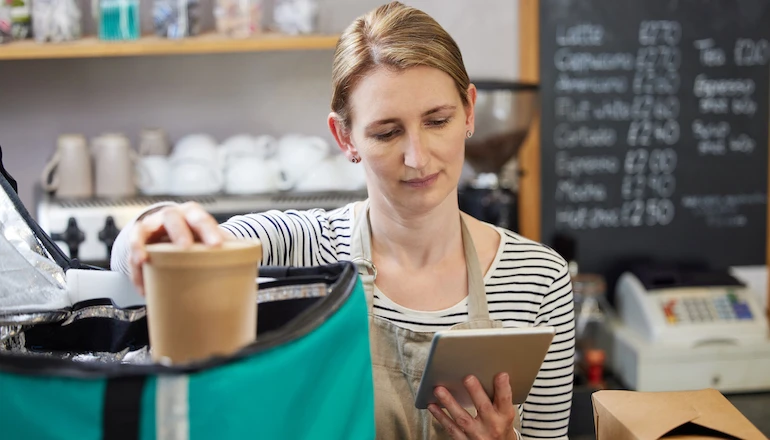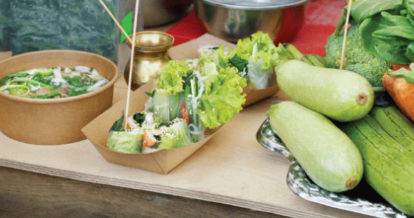What if you could save your restaurant seven dollars by investing one? Becoming an eco-friendly restaurant can help you achieve this goal.
A recent study analyzed the finances of 114 restaurants across 12 countries and found that each dollar invested in waste reduction led to cost savings of seven dollars.
This is one example of restaurants achieving enormous success by becoming environmentally sustainable. Sure, there are no guarantees you’ll achieve the same success by reducing waste, but you can come darn close by investing just a little more time, money, and resources into becoming a green restaurant.
“But what exactly does it mean to make your restaurant eco-friendly?”
“Are there benefits besides the cost savings?”
“What are the steps for my restaurant to go green?”
We’ve got all your restaurant questions covered.
You’ll walk away from this article with detailed knowledge on eco-friendly restaurants and feeling confident that you can run one – even if it means taking small steps today to achieve just a green tint.
Ready? Let’s get started.
What It Means to Go Eco-friendly for Your Restaurant
Sustainable restaurants take steps to reduce their impact on the environment by implementing various eco-conscious practices, such as:
- Recycling
- Adding vegan menu food options
- Reducing restaurant food waste
- Finding alternative energy sources
- Improving inventory management to avoid over-ordering perishables
A great example of a restaurant that embodies what it means to be green is Fields Good Chicken in New York. Fields Good Chicken has implemented green practices across its restaurant. The restaurant sources ingredients locally and uses 100% recyclable and compostable green packaging.

Why Choosing Eco-friendly Food Is a Good Business Decision
Like New York’s Fields Good Chicken, restaurants all over the U.S. and Canada are becoming green because they understand the environmental and business benefits.
Here are two reasons going green is the right business decision for your restaurant.
1. Cost Savings
Going green offers various cost savings. How much money you save depends on the number of and the type of green initiatives you implement at your restaurant.
If you switch to all green appliances, for example, you’ll save on energy.
Learn How to Be Eco-Conscious and Save Energy Over Time
Naturally, the more updated eco-friendly restaurant appliances you use, the more you save. Energy Star even has a tool that shows you exactly how much an American can save over time when they switch out an old fridge or freezer, based on the model they currently have and energy prices by state.
It’s also important to understand how time-of-use rates can also help restaurants save on energy. For example, it’s often cheaper to run appliances in the pm. instead of the am. That’s why it’s important to encourage staff to turn off kitchen equipment when it’s not in use.
2. Charge a Premium for Packaging
Several studies confirm that customers will pay more for environmentally friendly products. Asia Pulp and Paper, for example, discovered customers will gladly pay a premium for sustainable packaging. Nielsen found that customers will happily pay a premium for products if they’re organic and made by environmentally conscious companies.

3. Broader Guest Appeal
Going green allows you to appeal to a growing market that values sustainability and seeks out restaurants committed to social values.
4. Brand Benefits
Going green helps restaurants connect with environmentally aware customers and create positive perceptions of your brand. With an improved brand reputation, your customers will want to eat at your sustainable restaurant and likely recommend you to others. And just like that, you’ll receive free word-of-mouth marketing.
5. Boost in Sales and Profits
All the above benefits, when combined, lead to more customers, more sales, and – all things held equal – more profits.
How to Make Your Restaurant Ocean Friendly

Now that you know what it means to be eco-friendly and understand the benefits, let’s look at the many ways you can become a more ocean friendly restaurant. This section details 20 ways across six main categories:
- Minimizing waste
- Reducing energy consumption
- Purchasing reusable and recyclable materials
- Setting up recycling systems
- Creating a sustainable menu
- Using eco-friendly packaging
If a complete overhaul is too much for now, check out how to at least give your restaurant an eco-friendly tint. You can start small!
Category 1: Minimizing Food Waste
Think about how much food ends up wasted at your restaurant – maybe it’s plates of unfinished dishes your guests send back or greens that went bad. Here’s how to reduce this waste – and even save on food costs.
1. Reduce your portion sizes. You may want guests to feel like they’re getting good value for money, but if your kitchen consistently receives unfinished plates of food, consider reducing your portion sizes to go green – if only marginally.
2. Embrace zero-waste cooking. This is currently one of the hottest food trends, with many restaurants finding creative ways to make their food go further. Examples of how to reduce food waste in your restaurant include using leftover food for the special of the day and not wasting any ingredients. To make your business green, try using chicken bones in broths and stocks instead of discarding them or transforming carrot leaves into garnishes.
3. Improve inventory management. With inventory management, restaurants can better plan food orders and avoid over-ordering on perishables that can quickly spoil. If you’re unsure whether your inventory management is up to par, calculate your restaurant’s inventory turnover ratio.
This ratio tells you how fast you turnover inventory and how long you sit on specific perishables. From there you can make informed decisions that will improve your inventory management and reduce wastage.
Category 2: Reducing Energy Consumption
Restaurants use a lot of energy across three main areas: lighting, refrigeration, and cooling. Luckily, there are ways to reduce consumption, the demand for electricity, and ultimately the carbon emissions released when generating it.
4. Install energy efficient appliances. Look for Energy Star certified appliances that minimize energy usage.
5. Use energy saving lights, such as LED lighting.
6. Install occupancy sensors in freezers that shut down automatically to conserve energy.
7. Identify any energy leaks caused by faulty appliances and ensure you regularly repair equipment in your restaurant – especially those big-ticket items like refrigerators.
8. Use energy efficient insulation to reduce the amount of electricity used for heating and cooling.
9. Invest in renewable energy. You may recall the example of the Fields Good Chicken that uses sustainable packaging and sources ingredients locally. The restaurant also runs entirely on wind. This is renewable energy: energy you collect from natural resources – sun, wind, and water – and replenishes over time.
While many of the ways to conserve energy will involve an upfront cost, remember to consider the total cost of ownership. You’re decreasing energy consumption over the long term and will recoup this investment.
Category 3: Buying Reusable and Recyclable Supplies
The materials in your restaurant are also a prime candidate for various green initiatives.
10. Eliminate plastics. A current example of this is the industry shift around plastic straws and drinking cups. Many businesses are banning them or offering a green alternative (like glass, stainless steel, or compostable items).
11. Re-use items. Try purchasing reusable napkins you can wash.
12. Purchase 100% recyclable products. Examples include kitchen and bar mats, or chlorine-free toilet paper.
Category 4: Setting Up Recycling Systems
An article in the National Geographic highlights how many people believe they can toss all items in one bin without worrying about separating them.
The problem? The majority of items ending up in the blue bin can’t be recycled. “Such materials waste hauling space and fuel, jam up machinery, contaminate valuable materials, and pose hazards to workers,” explains Bryan Clark Howard, environmental journalist for National Geographic.
Make sure you implement the right systems from the start so that your recycling initiatives make a difference.
13. Include waste disposal bins in your restaurant clearly marked “recyclable” or “landfill,” so guests don’t put the wrong items in the wrong bins.
14. Send waste to a recycling stream instead of dumpsters. The added benefit here is that you’ll also reduce trash collection costs.
15. Understand local recycling rules in your area, so the process runs without a hitch.
Category 5: Creating a Sustainable Menu
Guests increasingly care about the origins of food, including whether ingredients were ethically sourced or if any animals were harmed.
As a result, veganism is on the rise. More restaurants are creating ethical food offerings to ensure they retain and attract guests while making a positive impact on the environment. Is it any surprise that the Vegetarian Journal’s Guide to Vegetarian and Vegan Dishes now lists 971 restaurants compared to 55 in 1993?
Here are several ways to create more eco-friendly food options and take advantage of the sustainability trend.
16. Add vegan menu items. You certainly don’t have to switch to a 100% plant-based food or focus on serving greens, but consider adding a variety of vegan dishes across your starters, mains, and desserts.
17. Source fresh and natural ingredients locally from ethical suppliers to reduce your environmental impact and save on transportation costs.
18. Update your food selection often with in-season produce. Seasonal produce is often grown closer to where it’s sold, meaning it only has to travel short distances which reduces its chances of spoiling.
19. Create your own garden so you can source fresh ingredients and greens for a salad or side dishes on-site while also saving on food costs. Temporis, a Michelin star restaurant in Chicago, has their own hydroponic gardens right on site. Your ingredients won’t get much fresher than that!
Category 6: Using Eco-friendly Packaging
Sustainability is not only about food. Consumers are putting increased pressure on companies to use sustainable packaging, with two-thirds of people in America now demanding it. This simply means your restaurant needs to make smart decisions about your packaging.
20. Invest in sustainable packaging. Consider switching from plastics and styrofoam to packaging that’s 100% recyclable, biodegradable, and eco-friendly.
Can’t Make a Big Commitment?
Twenty ways to help you go green may seem like a lot – and it is.
If you currently lack the time and resources to fully commit, here’s how to start making your restaurant green:
Start small by choosing only one category. Then, select one tactic, preferably one that’s easy to implement and will yield the most gains.
For instance, your energy consumption is generally a good place to start. You could install energy efficient lighting or even hire a professional for much-needed appliance repairs.
Regardless of where you choose to start, the important thing is to get started.
A Final Word on Going Eco-friendly
Going green and running an eco-friendly restaurant is good for the environment and a smart business decision. It offers cost savings, has a broad guest appeal, improves your brand reputation, and can even boost sales, profits, and positive reviews.
While there are undoubtedly many ways to realize these benefits and follow the path of eco-conscious restaurants – reducing food waste, managing your energy consumption, or creating a sustainable menu to name a few – know that you don’t have to wholeheartedly commit right out of the gate.
If you’re feeling stretched, take small steps. Make one simple change at a time. Over time these changes quickly add up.
Before you know it, you’ll move beyond just a green tint to running a restaurant that – like Fields Good Chicken – is genuinely eco-friendly.
Download our free inventory template
Sign up for our free weekly TouchBistro Newsletter







